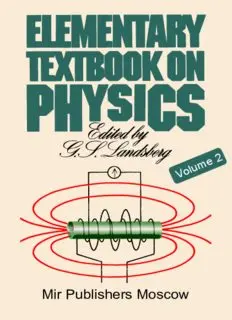
ELEMENTARY TEXTBOOK ON PHYSICS VOLUME 2 ELECTRICITY AND MAGNETISM PDF
Preview ELEMENTARY TEXTBOOK ON PHYSICS VOLUME 2 ELECTRICITY AND MAGNETISM
2 e m u o l V Mir Publishers Moscow ELEMENTARY TEXTBOOK ON PHYSICS Edited by G.S. Landsberg These three volumes form a course on elementary physics that has become very popular in the Soviet Union. Each sectioh was written by an authority in theappropriate field, while the overall unity and editing was supervised by Academician G.S. Landsberg (1890-1957). This textbook has gone through ten Russian editions and a great deal of effort went into the last edition to introduce SI units and change the terminology and notation for the physical units. A feature of this course is the relatively small number of formulas and mathematical manipulations. Instead, attention was focussed on explaining physical phenomena in such a way as to combine scientific rigour and a form understandable to school children.Another aspect of the text is the technological application of the physical laws. These features make the text a world-class textbook. For students preparing to enter universities andcolleges to study physics, and for those it high schools specialising in physics. ELEMENTARY TEXTBOOK ON PHYSICS Volume 2 SJlEMEHTAPHblM YMEBHMK 0M3MKM riofl pe^aKL^Meii aKafleMMKa T. C. /lAHflCBEPrA B 3-x TOMax TOM 2 3J1EKTPMHECTBO M MArHETM3M M3flaTenbCTBo «HayKa» Mockbs ELEMENTARY TEXTBOOK ON PHYSICS Edited by G. S. Landsberg In three volumes Volume 2 ELECTRICITY AND MAGNETISM Mir Publishers Moscow Translated from Russian by Natalia Wadhwa First published 1988 Revised from the 1985 Russian edition Ha ane/iuucKOM *3biKe Printed in the Union of Soviet Socialist Republics © H3,aaTejibCTBO «Hayica». TjiaBHaa peflaKima ISBN 5-03-000225-1 (J)H3HKo-MaTeMaTHHecKofl JiHTepaTypbi, 1985 ISBN 5-03-000223-5 © English translation, Mir Publishers, 1988 Contents From the Preface to the First Russian Edition 10 Chapter i. Electric Charges 11 1.1. Electric Interaction (11). 1.2. Conductors and Insulators (13). 1.3. Division of Bodies into Conductors and Insulators (15). 1.4. Positive and Negative Charges (17). 1.5. What Happens During Electrostatic Charging (19)? 1.6. Electron Theory (21). 1.7. Electrostatic Charging by Friction (22). 1.8. Charging by Induction (25). 1.9. Charging by Light. Photoelectric Effect (28). 1.10. Coulomb’s Law (29). 1.11. Unit of Charge (31). Chapter 2. Electric Field 34 2.1. Effect of Electric Charge on Surrounding Bodies (34). 2.2. The Idea of Electric Field (35). 2.3. Electric Field Strength (37). 2.4. Composition of Fields (39). 2.5. Electric Field in In sulators and Conductors (40). 2.6. Graphic Representation of Fields (41). 2.7. Main Features of Electric Field-Strength Patterns (45). 2.8. Application of the Method of Field Lines to Problems in Electrostatics (45). 2.9. Work Done in Displacing an Electric Charge in an Elec tric Field (48). 2.10. Potential Difference (Electric Voltage) (51). 2.11. Equipotential Surfaces (53). 2.12. Why Was the Potential Difference Introduced (55)? 2.13. Conditions for Charge Equilibrium in Conductors (57). 2.14. Electrometer (58). 2.15. What Is the Difference Be tween an Electrometer and an Electroscope (61)? 2.16. Earthing (62). 2.17. Measurement of the Potential Difference in Air. Electric Probe (63). 2.18. Electric Field of the Earth (65). 2.19. Simple Electric Field Configurations (66). 2.20. Charge Distribution in a Conductor. Faraday’s Cage (68). 2.21. Surface Charge Density (72). 2.22. Capacitors (73). 2.23. Types of Capacitors (77). 2.24. Parallel and Series Connection of Capacitors (80). 2.25. Dielectric Per mittivity (81). 2.26. Why Is Electric Field Weakened in a Dielectric? Polarization of Dielec trics (85). 2.27. Energy of Charged Bodies. Energy of Electric Field (87). Chapter 3. Direct Current 90 3.1. Electric Current and Electromotive Force (90). 3.2. Manifestations of Electric Cur rent (95). 3.3. Direction of Current (98). 3.4. Strength of Current (99). 3.5. “Velocity of Elec tric Current” and Velocity of Charge Carriers (100). 3.6. Galvanometer (101). 3.7. Voltage Distribution in a Current-Carrying Conductor (102). 3.8. Ohm’s Law (104). 3.9. Resistance of
